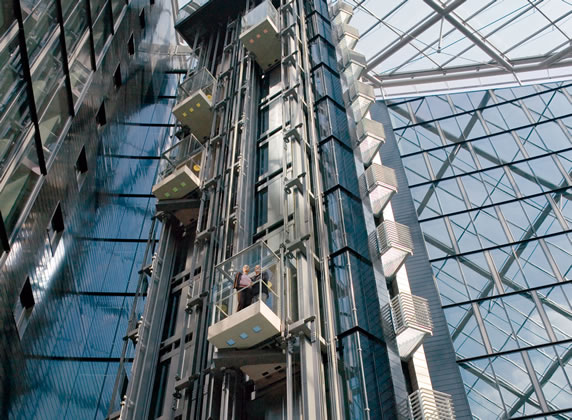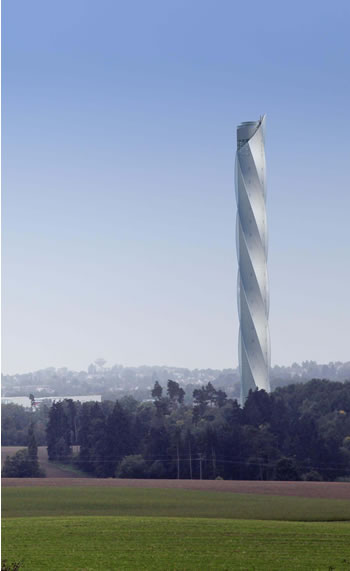
Though not currently approved for installation in the United States, multiple-car elevator systems (multiple cars sharing the same shaft) are increasingly being installed worldwide for their improved space efficiency and passenger capacity, as compared to single car systems.
The idea of having an elevator with two independent cabs operating in the same shaft dates back to the 1920s, when Sprague’s Dual Elevator System operated in a 20-story Pittsburgh building. It was taken out of service in 1931 and it wasn’t until 2002, when ThyssenKrupp Elevator AG announced its multiple-car elevator system, that we’d see two lifts using the same hoist-way again.
ThyssenKrupp Elevator’s TWIN multiple-car elevator system made its world debut in 2002 in a pilot project carried out with the University of Stuttgart in Germany. The number of students there had risen steadily over the years, straining the capacity of the university’s conventional elevator installation. One of its six shafts was converted to the multiple-car elevator system, and the benefits were immediate. The project won 1st prize for a modernization project in the Elevator World Project of the Year Awards 2004.
In a multiple-car elevator system, each car has its own counterweight and separate safety and drive equipment – but both cars use the same guide rails and shaft doors. To prevent elevator cars from colliding with each other, they are mechanically interlocked by bidirectional, one-way clutch systems. The one-way clutch ensures all elevator cars move only in one direction at a time. Each elevator car is also protected by independent brake systems, automatic monitoring of minimum safety distances, emergency stop function if the safety distance is breached, and automatic engagement of the safety device in the unlikely event that all else fails.
Using multiple cars in the same shaft (up to three cars in a shaft), can save precious space in a tall building by reducing the need for additional shafts. In a retrofit, a freed-up shaft can be recovered, for example, to lay IT cables or for HVAC systems. The multiple-car elevator system can also allow a building to provide different types of lift service. For example, a tall residential building might employ the top car to service upper floors and penthouses, while the bottom car services lower floors.
The multiple-car elevator system concept not only allows for increased passenger capacity, it is also extremely cost-efficient: individual elevators are traction elevators assembled from standard components. Each equipped with their own drive sheave and counterweights, they travel independently of one another on the same guide rails. Installing two cars in one shaft involves limited additional efforts, but in return the system offers a completely new transportation concept for high-rise buildings.
A modern destination selection control system is an essential part of a multiple-car system. Prior to entering the cab, the passenger selects her destination via a touch screen and is assigned the most suitable car. Thanks to significantly reduced waiting times and minimum stops en-route, passengers reach their destinations quickly and conveniently. This type of control system also has a positive effect on energy consumption by minimizing the number of empty trips made by the cars.
Destination selection control systems not only optimize the flow of passengers in buildings – they can also be adapted to the needs of building owners. For example, it is possible to regulate access to specific floors by entering a code.

ThyssenKrupp has announced plans for an 800-foot-tall tower for testing elevator lifts. The proposed tower will be one of the tallest structures in Germany, higher than the viewing platform of the iconic Berlin TV tower. The new structure will be used to test and certify elevators for mid and high-rise buildings before and while the buildings are being constructed, thus reducing installation times.
Already being used successfully in buildings around the world, multiple-car systems have been installed in the United Kingdom, Spain, Germany, Russia and South Korea. Further systems are being installed or planned in the UK, the Netherlands, Germany, Russia, Saudi Arabia, the United Arab Emirates, South Korea and Australia.
Two multiple-car elevator systems and one conventional elevator are being installed as part of a modernization project at Ajou University Hospital in the South Korean city of Suwon. After the replacement of three traditional single elevators that have reached their capacity limits, five cabs will be available, allowing significantly more passengers to be transported in the same amount of space. Thanks to an intelligent destination control system, waiting times for hospital patients, staff and visitors will be shortened. With more than 1,000 beds, 92 intensive care places and 18 operating rooms, Ajou University Hospital is one of the largest and most modern medical facilities in the country.
In Moscow, a new international business center known as the IQ-quarter will use 22 multiple-car elevator systems with a total of 44 cabs, 23 conventional elevators, and 16 escalators. The IQ-quarter consists of a total of three towers of different heights (21, 33 and 42 floors) and a transportation terminal. While top class offices with a total area of 123,000 square meters will be created in the two 33- and 42-floor high-rise buildings, the third tower with 21 floors will accommodate several premium class apartments and an exclusive five-star Sofitel hotel with 159 rooms. The first and ground floors of the three towers will be united by an atrium with restaurants, shops, fitness studios, air ticket offices and banks.
ThyssenKrupp’s multiple-car elevator system is currently approved for speeds of 8 meters (26 feet) per second, but they are working to overcome this barrier. In 2004 a research and development center was opened in Stuttgart, Germany which is working closely with other research centers in North America and France. In addition, the company has announced plans for an 800-foot-tall test tower in Rottweil, Germany. The proposed tower will be one of the tallest structures in Germany and will be used to test and certify elevators for mid and high-rise buildings before and while the buildings are being constructed, thus reducing installation times.
Images courtesy of ThyssenKrupp Elevator

